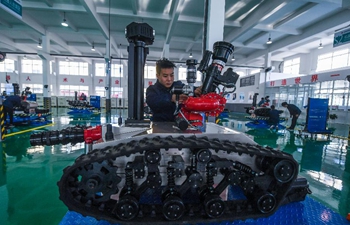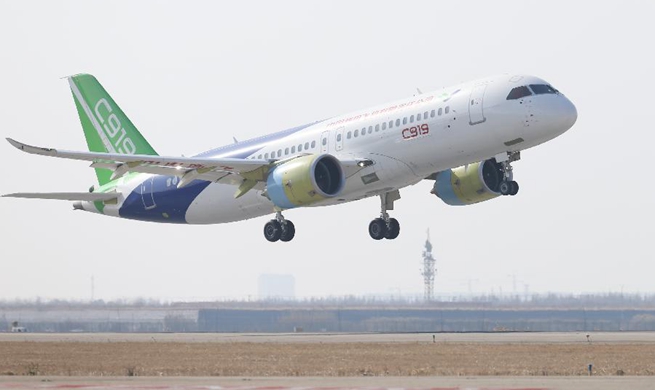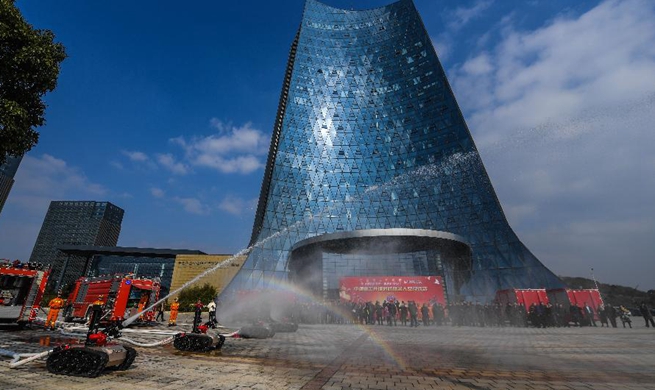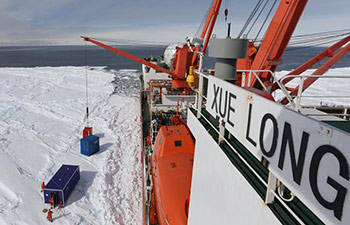KUALA LUMPUR, Dec. 17 (Xinhua) -- Yi Dai Yi Lu, or Belt and Road Initiative, is one of the few Chinese phrases 24-year-old Mohd Syamin Bin Zainol is able to speak in Chinese after taking part in a railway workshop.
However, he is enthusiastic about the prospects of the East Coast Rail Link (ECRL), the first artery railway built in the east coast of Peninsula Malaysia.
"I hope to become an engineer for ECRL since the railway project will considerably improve the transportation infrastructure in my hometown," said Syamin, a native of the Malaysian state of Pahang, in which the ECRL will traverse.
The workshop, organized by China Communications Construction Company (CCCC), Malaysia Rail Link and Pahang University, aims to help Malaysia cultivate railway talent, as the country is in an infrastructure expansion boom.
The CCCC, a leading transportation infrastructure group that also builts a landmark bridge in the northwestern state of Penang, will lead the construction of ECRL.
Fang Zhenru, CCCC's ECRL project director, said as the Malaysian government puts more efforts in enhancing railway transportation, a large number of professional talents will be needed. "Cultivating local talents will help achieve win-win results, and boost employment," said Fang.
According to the plan of CCCC, by 2022, more than 3,600 professionals related to the railway industry are expected to graduate from the workshops.
The joint railway talent cultivation workshop is only part of the expanding railway cooperation between Malaysia and China, especially under the Belt and Road Initiative.
Proposed by China in 2013, the Belt and Road Initiative aims to build a trade and infrastructure network connecting countries along and beyond the ancient Silk Road trade routes. It comprises the Silk Road Economic Belt and the 21st Century Maritime Silk Road.
Aside from the 688-km ECRL which will cost 55 billion ringgit (13.5 billion U.S. dollars), a Chinese consortium also won the contract for the electrified double-tracking project of the railway line between Gemas and Johor Baru in southern Malaysia. As for the high speed rail linking Kuala Lumpur and Singapore, Chinese companies also have long expressed interests.
There is a reason for China's dominance in Malaysian railway projects. Construction giants like the CCCC not only bring the best technologies they can offer, but also create enormous new job opportunities.
Besides, China also helped Malaysia in financing the projects. In the case of ECRL, the Export-Import Bank of China financed 85 percent of the railway with soft loans, while the Malaysian government provided the remaining 15 percent.
The CCCC's president Liu Qitao told Xinhua that more than 80,000 new jobs will be created during the construction period of ECRL, while some 6,000 jobs will be retained after the completion of the project.
As Malaysia's transport minister, Liow Tiong Lai knows better about Chinese-made rolling-stock. After visiting the headquarters of China Railway Rolling-stock Corp. (CRRC) in Changsha earlier this year, Liow pledged that Malaysia will purchase more Chinese-made trains.
First of all, it is because of the high quality and low maintenance fee, he said, adding that it also took into account about CRRC's localization efforts, including a rolling-stock assembling factory in the Malaysian state of Perak.
When attending the foundation-laying ceremony for ECRL, Chinese State Councillor Wang Yong praised the ECRL as a "flagship project" jointly built by the two countries under the Belt and Road Initiative, which will boost economic transformation and balanced development of different regions in Malaysia.
He also expressed hope that the two countries could seize the historic opportunity brought by the initiative to achieve win-win results and joint development.
In a broader sense, railway cooperation between China and Malaysia also embodies China's commitment to help develop railway infrastructures in the Southeast Asian region.
A report released by HSBC in November, said that major rail lines, under construction or to be developed under the Belt and Road Initiative, will increase the volume and efficiency of intra-regional trade, and increase the productivity of the region with more efficient transportation.

















